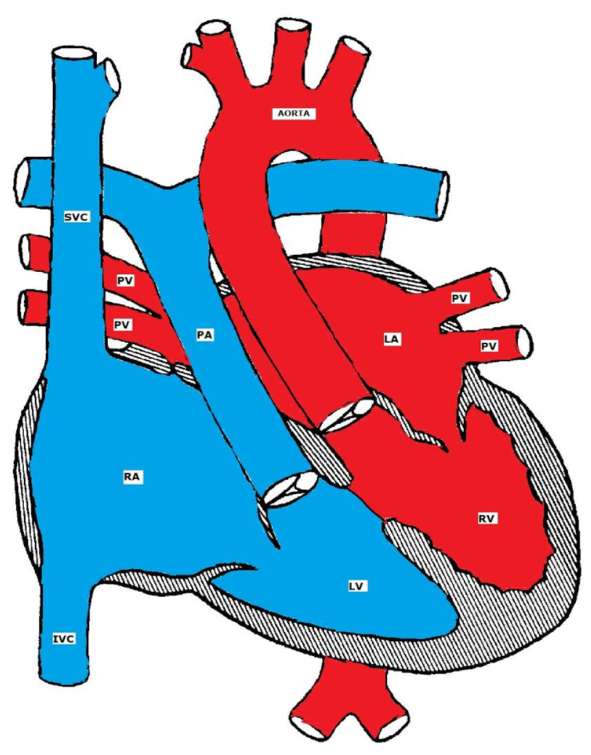
Congenital heart defects (CHDs) represent a significant class of cardiovascular disorders, typically present at birth, with diverse manifestations and varying degrees of severity. Among these conditions, certain defects necessitate the continued patency of the ductus arteriosus, a fetal blood vessel that normally closes shortly after birth. For infants with specific congenital heart defects, maintaining the ductus arteriosus open can be life-saving, enabling proper blood flow and preventing severe circulatory complications. This article delves into congenital heart defects requiring patency of ductus arteriosus, exploring their causes, implications, and current treatment strategies.
What is the Ductus Arteriosus?
The ductus arteriosus is a vital vascular structure present during fetal development. It serves as a connection between the pulmonary artery and the aorta, bypassing the lungs—an organ that is not yet functional in utero. This temporary vessel allows blood to flow directly into the aorta, circumventing the lungs, which are not yet needed for oxygenation. After birth, the ductus arteriosus typically closes within the first 24 to 72 hours of life as the lungs begin functioning and oxygen levels rise.
In some cases, however, the ductus arteriosus fails to close, leading to a condition known as patent ductus arteriosus (PDA). In certain congenital heart defects, maintaining this ductus open is crucial to support the proper circulation of blood through the body, particularly in infants with severe structural heart abnormalities.
Common Congenital Heart Defects Requiring Patency of Ductus Arteriosus
1. Hypoplastic Left Heart Syndrome (HLHS)
Hypoplastic left heart syndrome is one of the most complex and severe congenital heart defects. In HLHS, the left side of the heart, including the left ventricle, mitral valve, and aortic valve, is underdeveloped. This prevents effective blood flow to the body. In these cases, maintaining the ductus arteriosus open ensures continued blood circulation from the right side of the heart to the aorta and the systemic circulation. Without this connection, infants with HLHS cannot survive without surgical intervention.
2. Transposition of the Great Arteries (TGA)
In transposition of the great arteries, the pulmonary artery and aorta are reversed, which results in oxygen-poor blood being circulated throughout the body while oxygen-rich blood circulates to the lungs. In this situation, the patency of the ductus arteriosus allows oxygenated blood to flow from the lungs into the systemic circulation via the aorta, bypassing the faulty arterial connections. This is critical for survival in the immediate postnatal period before corrective surgery is performed.
3. Tricuspid Atresia
Tricuspid atresia is a condition where the tricuspid valve, which normally separates the right atrium and right ventricle, fails to form. As a result, blood cannot flow from the right atrium to the right ventricle, which impairs pulmonary circulation. The ductus arteriosus in tricuspid atresia helps provide the necessary blood flow from the right atrium to the pulmonary arteries, enabling the infant to receive adequate oxygenation before corrective surgery can be performed.
4. Pulmonary Atresia with Intact Ventricular Septum
Pulmonary atresia is a condition where the pulmonary valve fails to form, resulting in no blood flow from the right ventricle to the lungs. In such cases, maintaining the ductus arteriosus open ensures that blood can still reach the lungs for oxygenation, bypassing the blocked pulmonary valve. The ductus arteriosus is typically kept patent until surgical interventions, such as creating a new pathway for blood to flow to the lungs, can be performed.
Mechanisms of Patency Maintenance
In neonates with congenital heart defects requiring ductus arteriosus patency, various medical interventions are employed to keep the ductus open until further treatment can be initiated. These methods include:
Prostaglandin E1 (PGE1) Therapy
One of the most common and effective treatments for maintaining ductus arteriosus patency in infants with congenital heart defects is the administration of prostaglandin E1 (PGE1). This synthetic medication acts as a vasodilator, helping to keep the ductus arteriosus open by relaxing the smooth muscle of the vessel. PGE1 is administered intravenously and requires close monitoring due to potential side effects, including hypotension and respiratory complications.
Surgical Interventions
In cases where PGE1 therapy is insufficient or cannot be continued long-term, surgical interventions may be necessary. Procedures such as a balloon atrial septostomy or direct surgical closure of the ductus arteriosus may be considered to address the underlying defect and ensure adequate blood flow. Surgical correction may be performed in stages, particularly in conditions like HLHS, where a multi-step approach is required.
Diagnosis of Congenital Heart Defects Requiring Ductus Arteriosus Patency
The diagnosis of congenital heart defects that require ductus arteriosus patency typically occurs shortly after birth. Physicians may suspect a defect based on clinical signs such as cyanosis (a bluish tint to the skin), difficulty breathing, or failure to thrive. Diagnosis is confirmed through a combination of:
- Echocardiogram: This non-invasive imaging test provides real-time images of the heart and blood vessels, allowing doctors to identify structural abnormalities, such as a patent ductus arteriosus or other congenital defects.
- Cardiac Catheterization: In some cases, a catheter may be inserted into the heart to measure pressures within the chambers and blood vessels, helping to further evaluate the severity of the defect.
- X-rays and MRI: These imaging techniques can assist in assessing the overall heart structure and function.
Treatment Approaches and Long-Term Outlook
Treatment for congenital heart defects requiring ductus arteriosus patency is often multifaceted and depends on the specific defect. Immediate management typically includes pharmacological interventions like PGE1 to maintain ductal patency, while surgical correction is necessary to address the underlying heart defect.
The long-term prognosis for infants with these conditions depends on the severity of the heart defect, the timing and success of interventions, and ongoing medical care. While many congenital heart defects can be treated successfully, some conditions may require lifelong follow-up and additional surgeries.